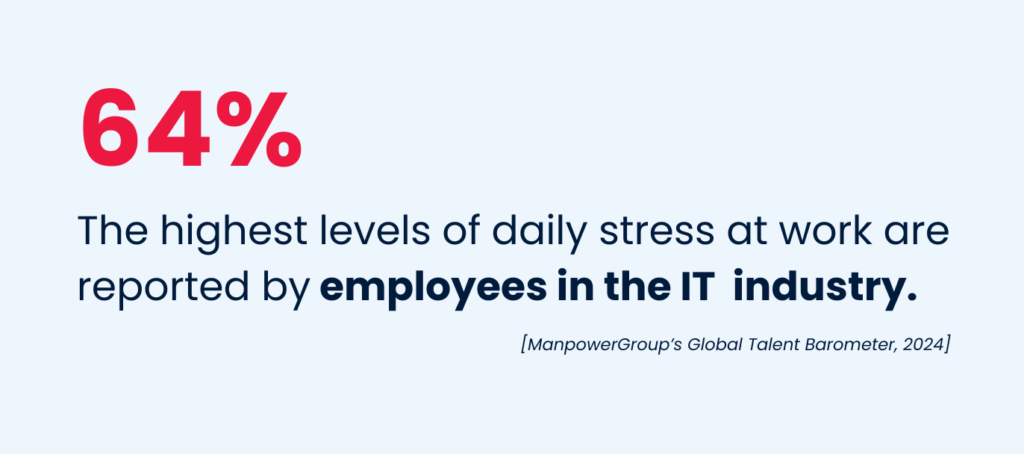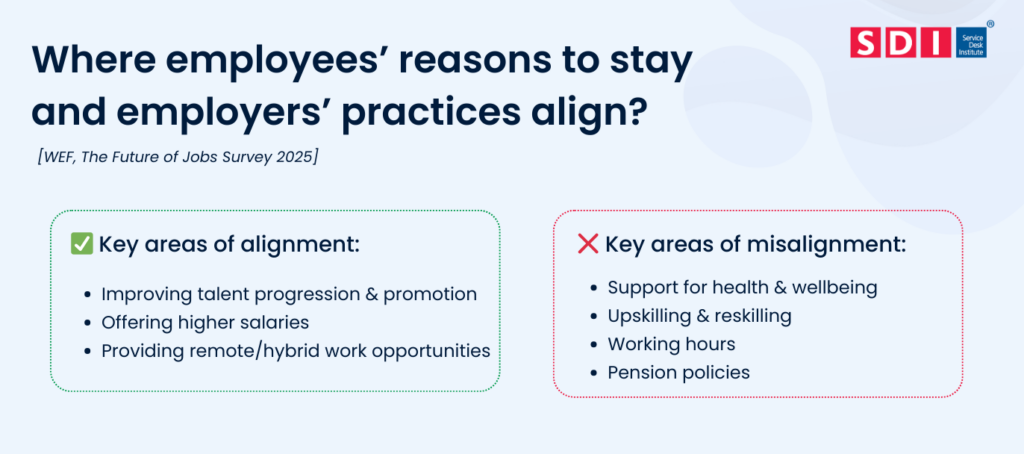 Back to Resources
Back to Resources
The IT industry is going through some exciting changes, with AI, automation, and digitalisation really shaking things up in the workplace. This creates both challenges and opportunities for IT professionals looking to future-proof their careers.
But to keep up with emerging technologies, employees must adapt quickly, upskill, and embrace broader responsibilities.
So, there are some important questions we need to ask: Are we doing enough to hold onto our talented professionals and provide the necessary support they need?
The 2025 UK Talent Shortage Survey shows a slight drop in the talent gap, from 80% to 76%, indicating businesses’ efforts are starting to pay off. But fewer job openings are also easing demand, raising concerns about a potential hiring recession. Globally, 74% of employers struggle to find skilled talent.
With a significant portion of IT professionals considering leaving their roles, it’s time to examine whether the industry is keeping pace with employee expectations.
We know talent retention is more than just about pay. It involves worklife balance, job satisfaction, career growth, and wellbeing.
⚡ In this blog, we’ll look at:
- What is employee retention?
- Statistics on what’s keeping employees in their workplace.
- What can organisations do to improve employee retention?
- What does the future hold for worklife in ITSM?
What Is Employee Retention?
Simply put, employee retention is an organisation’s ability to keep its employees over a period of time. It is a key measure of job satisfaction, company culture, and the effectiveness of HR policies.
If we only look at the IT industry, skills shortages are very common, and competition for top talent is often high. This means that retaining employees is becoming even more important to maintaining business continuity and innovation.
What is a good employee retention rate?
A good employee retention rate varies by industry, but a retention rate of 85% or higher is generally considered good in the IT industry. This means that a good employee turnover rate would be around 10%.
Statistics On What’s Keeping Employees in Their Workplace
According to our ‘The Future of Worklife in ITSM’ research in 2023, 42% of IT professionals said they were seriously considering leaving their current roles. What’s more interesting is that the same research found that 72% of IT professionals stated they were happy in their roles, but that doesn’t necessarily mean they plan to stay.
This raises concerns about the long-term sustainability of IT teams and their ability to support businesses effectively.
So, has this changed today?
Based on the ManpowerGroup, Global Talent Barometer, 80% of respondents find meaning in their work today. But a third of UK employees still feel stuck in their careers, with limited chances for growth and a lack of trust in management. As a result, 34% plan to leave their jobs in the next six months.
Interestingly, despite higher wellbeing and worklife balance, 60% of remote workers are likely to change jobs.
The same report also found that nearly 48% of UK workers experience daily stress at work, with only 24% feeling fully supported by their employer regarding wellbeing. The highest levels of daily stress at work are reported by employees in the IT sector (64%).
This suggests that while some companies have made progress, some are still struggling to prioritise the key motivators for employees in their retention strategies.
So, what really keeps employees in their current roles?
What Can Organisations Do to Improve Employee Retention?

Based on the latest WEF The Future of Jobs Survey 2025, employers are less positive in their ability to retain talent than they were two years ago.
If we look at the employer perspectives from the Future of Jobs Survey and employee insights from ADP Research, there are key factors influencing talent retention and attraction.
The findings reveal both areas of alignment and misalignment between employers and employees.
✅ Key areas of alignment:
- Improving talent progression & promotions: Both employers and employees consider this very important for retention and talent attraction.
- Higher salaries: Employers understand that offering higher pay is essential to attracting and keeping skilled workers, while employees see fair compensation as a fundamental reason to remain in a job.
- Remote/hybrid work: Businesses acknowledge that offering flexible schedules helps retain talent and improves job satisfaction. At the same time, employees increasingly expect the ability to work flexibly as part of a modern work environment.
❌Key areas of misalignment:
- Support for health & wellbeing: Employers consider workplace wellbeing initiatives essential for maintaining a productive workforce, but employees do not view them as the main factor in their decision to stay in a job.
- Upskilling & reskilling: Employers view continuous learning as vital for staying competitive, but employees are not prioritising it on the same level. This might suggest that employees may either not see immediate personal benefits of upskilling or reskilling or prefer direct career advancement opportunities over additional training.
- Working hours: Employees place high importance on flexible working hours, while many employers do not see working hours as a primary factor in keeping employees engaged.
- Pension policies: This misalignment suggests that businesses may be underestimating the importance of financial stability in employees’ long-term career decisions.
To improve talent retention, organisations should adopt a more people-centric approach. This means adopting strategies that bridge the gap between employer priorities and employee expectations, ensuring policies align with what truly matters to the workforce.
Here are some of the strategies that can improve employee retention:
- Enhancing worklife balance – Employees truly value flexibility in how and where they work. So, offering flexible schedules, performance-based metrics, mental health support, and autonomy in how work is done can help create an environment in which employees want to be a part.
- Investing in career development – Ensuring clear long-term pathways for growth, supporting mentorship programmes, upskilling, and reskilling initiatives that can help employees see a future within the company.
- Fostering a positive work culture – Giving employees a voice at any time, recognising, and rewarding success and nurturing ethical leadership can improve job satisfaction.
- Balancing AI implementation – Ensuring that automation supports employees rather than replacing them can reduce uncertainty and improve employee engagement.
What Does the Future Hold for Worklife In ITSM?
The IT industry is making strides in talent retention, but the data suggests much work still needs to be done. While salaries and job security are important, the bigger challenges lie in career growth, flexibility, wellbeing, and adapting to AI-driven change.
📢 We’d love to hear from you! What do you think about the future of worklife in ITSM? What makes you stay in your current role? Share your perspective in our survey.
Take our survey and share your insights—it only takes 15-20 minutes, and your voice will help shape the future of ITSM.

















